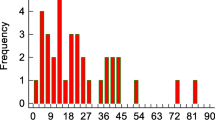Abstract
Purpose
Non-aneurysmal perimesencephalic subarachnoid hemorrhage (PmSAH) represents 6.8% of spontaneous subarachnoid hemorrhage, and usually has a benign clinical course. However, patients might have early cerebral ischemic lesions and long-term neurocognitive complaints. Cerebral atrophy has been described in patients after aneurysmal SAH, but not in PmSAH. We aimed to investigate if PmSAH associates with increased brain volume loss.
Methods
In this prospective study, we included consecutive patients with PmSAH that performed MR in the first 10 days after hemorrhage, and follow-up MR 6–7 years later. Automated volumetric measurements of intracranial, white matter, gray matter, whole brain, lateral ventricles, hippocampus, and amygdala volumes were performed. Volumes were compared to a normal population, matched for age.
Results
Eight patients with PmSAH were included, with a mean age of 51.5 (SE 3.6) at baseline. The control group included 22 patients with a mean age of 56.3 (SE 2.0). A relative reduction of all volumes was found in both groups; however, PmSAH patients had significant reductions in intracranial, white and gray matter, whole brain, and hippocampal volumes when compared to controls. These changes had a higher magnitude in whole brain volume, with a significant absolute decrease of 6.5% in PmSAH patients (versus 1.9% in controls), and a trend for an increase in lateral ventricle volume (absolute 21.3% increase, versus 3.9% in controls).
Conclusion
Our cohort of PmSAH patients showed significant long-term parenchymal atrophy, and higher global and focal parenchymal volume loss rates when compared to a non-SAH population.

Similar content being viewed by others
Abbreviations
- PmSAH:
-
Non-aneurysmal perimesencephalic subarachnoid hemorrhage
- SAH:
-
Subarachnoid hemorrhage
- ICC:
-
Intracranial cavity
- WM:
-
White matter
- GM:
-
Gray matter
- CSF:
-
Cerebrospinal fluid
- GCS:
-
Glasgow coma score
References
Mensing LA, Vergouwen MDI, Laban KG et al (2018) Perimesencephalic hemorrhage: a review of epidemiology, risk factors, presumed cause, clinical course, and outcome. Stroke 49:1363–1370. https://doi.org/10.1161/STROKEAHA.117.019843
Beseoglu K, Pannes S, Steiger HJ, Hänggi D (2010) Long-term outcome and quality of life after nonaneurysmal subarachnoid hemorrhage. Acta Neurochir (Wien) 152:409–416. https://doi.org/10.1007/s00701-009-0518-8
Konczalla J, Platz J, Schuss P et al (2014) Non-aneurysmal non-traumatic subarachnoid hemorrhage: patient characteristics, clinical outcome and prognostic factors based on a single-center experience in 125 patients. BMC Neurol. https://doi.org/10.1186/1471-2377-14-140
Konczalla J, Schmitz J, Kashefiolasl S et al (2015) Non-aneurysmal subarachnoid hemorrhage in 173 patients: a prospective study of long-term outcome. Eur J Neurol 22:1329–1336. https://doi.org/10.1111/ene.12762
Greebe P, Rinkel GJE (2007) Life expectancy after perimesencephalic subarachnoid hemorrhage. Stroke 38:1222–1224. https://doi.org/10.1161/01.STR.0000260093.49693.7a
Fragata I, Canto-Moreira N, Canhão P (2019) Ischemic lesions in acute and subacute perimesencephalic subarachnoid hemorrhage. Am J Roentgenol 212:418–424. https://doi.org/10.2214/AJR.18.19700
Boerboom W, Heijenbrok-Kal MH, Khajeh L et al (2014) Differences in cognitive and emotional outcomes between patients with perimesencephalic and aneurysmal subarachnoid haemorrhage. J Rehabil Med 46:28–32. https://doi.org/10.2340/16501977-1236
Madureira S, Canhão P, Guerreiro M, Ferro JM (2000) Cognitive and emotional consequences of perimesencephalic subarachnoid hemorrhage. J Neurol 247:862–867. https://doi.org/10.1007/s004150070074
Marquardt G, Niebauer T, Schick U, Lorenz R (2000) Long term follow up after perimesencephalic subarachnoid haemorrhage [16] (multiple letters). J Neurol Neurosurg Psychiatry 69:127–130. https://doi.org/10.1136/jnnp.70.3.419
Bendel P, Koivisto T, Aikia M et al (2010) Atrophic enlargement of CSF volume after subarachnoid hemorrhage: correlation with neuropsychological outcome. Am J Neuroradiol 31:370–376. https://doi.org/10.3174/ajnr.A1804
Bendel P, Koivisto T, Hanninen T et al (2006) Subarachnoid hemorrhage is followed by temporomesial volume loss: MRI volumetric study [3]. Neurology 67:575–582. https://doi.org/10.1212/01.wnl.0000262956.27015.9d
Manjón JV, Coupé P (2016) Volbrain: an online MRI brain volumetry system. Front Neuroinform 10:1–14. https://doi.org/10.3389/fninf.2016.00030
Coupé P, Manjón JV, Fonov V et al (2011) Patch-based segmentation using expert priors: application to hippocampus and ventricle segmentation. Neuroimage 54:940–954. https://doi.org/10.1016/j.neuroimage.2010.09.018
Lee GY, Ryu CW, Ko HC, Jahng GH (2020) Correlation between gray matter volume loss followed by aneurysmal subarachnoid hemorrhage and subarachnoid hemorrhage volume. Neuroradiology 62:1401–1409. https://doi.org/10.1007/s00234-020-02445-5
Hedderich DM, Reess TJ, Thaler M et al (2019) Hippocampus subfield volumetry after microsurgical or endovascular treatment of intracranial aneurysms-an explorative study. Eur Radiol Exp 3:13. https://doi.org/10.1186/s41747-019-0092-7
Hasegawa Y, Suzuki H, Sozen T et al (2011) Apoptotic mechanisms for neuronal cells in early brain injury after subarachnoid hemorrhage. Acta Neurochir Suppl 110:43–48. https://doi.org/10.1007/978-3-7091-0353-1
Cahill WJ, Calvert JH, Zhang JH (2006) Mechanisms of early brain injury after subarachnoid hemorrhage. J Cereb Blood Flow Metab 26:1341–1353. https://doi.org/10.1038/sj.jcbfm.9600283
Frontera JA, Ahmed W, Zach V et al (2015) Acute ischaemia after subarachnoid haemorrhage, relationship with early brain injury and impact on outcome: a prospective quantitative MRI study. J Neurol Neurosurg Psychiatry 86:71–78. https://doi.org/10.1136/jnnp-2013-307313
Edward Coffey C, F. Lucke J, A. Saxton J, et al (1998) Sex differences in metabolic brain aging. Arch Neurol 55:169–179. https://doi.org/10.1073/pnas.1904673116
Funding
No funding was received for conducting this study.
Author information
Authors and Affiliations
Corresponding author
Ethics declarations
Conflict of interest
The authors have no relevant financial or non-financial interests to disclose.
Ethical approval
All procedures performed in studies involving human participants were in accordance with the ethical standards of the institutional and/or national research committee and with the 1964 Helsinki declaration and its later amendments or comparable ethical standards.
Informed consent
Informed consent was obtained from all individual participants included in the study.
Additional information
Publisher's note
Springer Nature remains neutral with regard to jurisdictional claims in published maps and institutional affiliations.
Supplementary Information
Below is the link to the electronic supplementary material.
Rights and permissions
About this article
Cite this article
Gama Lobo, G., Fragata, I. Long-term global and focal cerebral atrophy in perimesencephalic subarachnoid hemorrhage—a case–control study. Neuroradiology 64, 669–674 (2022). https://doi.org/10.1007/s00234-021-02804-w
Received:
Accepted:
Published:
Issue Date:
DOI: https://doi.org/10.1007/s00234-021-02804-w




